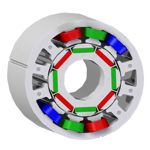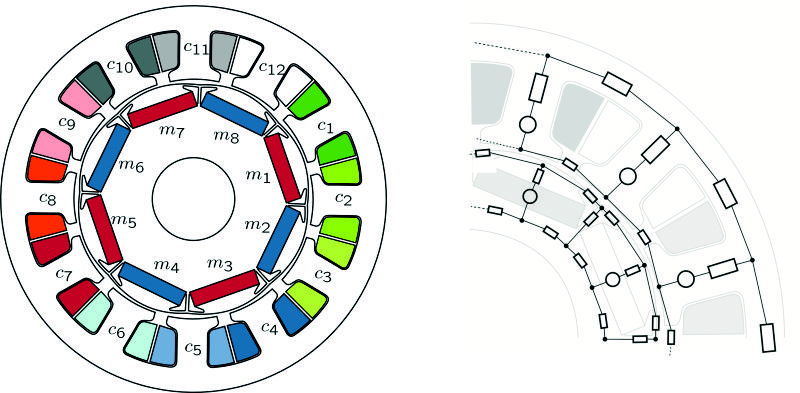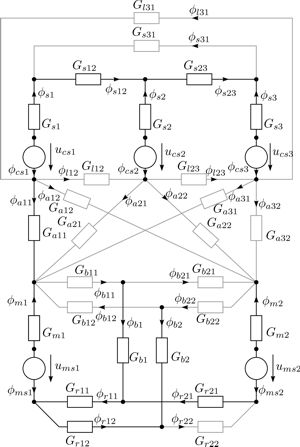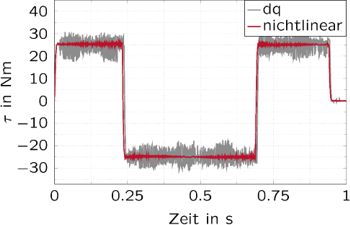
Modellierung und optimale Regelung von Permanentmagnet-Synchronmotoren
Projektschwerpunkte
- Reluktanzmodellierung von Permanentmagnet-Synchronmotoren (PMSM)
- Systematische Berücksichtigung von magnetischer Sättigung und nicht-sinusförmiger Feldverläufe
- Optimale Regelung des Moments
- Sensorlose Verfahren zur Positionsbestimmung von PMSM
Beschreibung
Permanentmagnet-Synchronmotoren (PMSM) werden in vielen industriellen Anwendungen, wie z.B. der Robotik, aufgrund ihrer hohen Momentendichte und hohen energetischen Effizienz eingesetzt. Für die Regelung von PMSM ist die feldorientierte Regelung industrieller Standard. Diese Regelungsstrategie beruht auf einer Transformation der winkelabhängigen Größen des PMSM auf ein mit dem Rotor fest verbundenes orthogonales dq0-Koordinatensystem. Wesentliche Annahme ist dabei die magnetische Linearität des Motors sowie eine Grundwellenapproximation der Feldgrößen des Motors.
Moderne Motorkonstruktionen verwenden meist Einzelzahnspulen und einen nicht homogenen Luftspalt, wodurch die Annahme sinusförmigen Verläufe mehr oder weniger verletzt ist. Weiterhin werden PMSM häufig bis in den Bereich maßgeblicher Sättigung betrieben. Damit sind die Annahmen der klassischen feldorientierten Regelung in vielen Anwendungen mehr oder weniger verletzt.
In dieser Forschungskooperation mit der Firma Bernecker und Rainer Industrieelektronik GmbH (B&R) werden Methoden zur systematischen mathematischen Beschreibung von PMSM mit ausgeprägter Sättigung sowie nicht sinusförmigen Feldgrößen untersucht. Dazu wird die Methode der Reluktanzmodellierung angewandt, bei der der magnetische Kreis des PMSM mit einer Verschaltung von magnetischen Widerständen (Reluktanzen) und magnetischen Spannungsquellen (Spulen, Permanentmagnete) approximiert wird, siehe Abb. 1.

Schnitt und mögliche Reluktanzmodellierung eines typischen PMSM
Die Anwendung der aus der elektrischen Schaltungstechnik bekannten Netzwerkstheorie erlaubt eine systematische Bestimmung der Modellgleichungen für beliebige Motorkonstruktionen mit relativ komplexen Reluktanznetzwerken, siehe z.B. Fig. 2. Weiterhin können damit systematisch magnetische Sättigung und nicht sinusförmige Feldgrößen berücksichtigt werden.

Reluktanznetzwerk eines typischen PMSM
Da sich diese Modelle auch durch eine relativ geringe Modellkomplexität auszeichnen, sind diese Modelle eine gute Basis für modellbasierte Regelungsstrategien. Im Rahmen dieses Forschungsprojektes werden optimierungsbasierte Regelungsstrategien entwickelt, die z.B. eine indirekte Momentenregelung mit gleichzeitiger Minimierung der Verluste des PMSM erlauben. Damit lässt sich eine wesentliche Verbesserung der Momentenregelgüte im Vergleich zu einer klassischen feldorientierten Regelungsstrategie erreichen, siehe z.B. Abb. 3.

Momentenregelgüte der entwickelten nichtlinearen Regelungsstrategie im Vergleich zu einer feldorientierten Regelung (dq)
Der modellbasierte Ansatz erlaubt die einfache Übertragung auf andere Baugrößen und Bauformen von elektrischen Motoren. Insbesondere lassen sich die Ergebnisse auch auf Linearmotoren übertragen. Weiterhin bilden die mathematischen Modelle eine gute Basis auch für die sensorlose Positionsbestimmung von PMSM.
Ausgewählte Publikationen
- D. Faustner, W. Kemmetmüller, and A. Kugi, Flatness-Based Torque Control of Saturated Surface-Mounted Permanent Magnet Synchronous Machines, IEEE Transactions on Control Systems Technology, vol. 24, iss. 4, p. 1201–1213, 2016.
[BibTex] [Download]@Article{Faustner16, Title = {Flatness-Based Torque Control of Saturated Surface-Mounted Permanent Magnet Synchronous Machines}, Author = {Faustner, D. and Kemmetm{\"u}ller, W. and Kugi, A.}, Journal = {IEEE Transactions on Control Systems Technology}, Pages = {1201--1213}, Volume = {24}, Year = {2016}, Number = {4}, Doi = {10.1109/TCST.2015.2501345}, ISSN = {1063-6536}, } - D. Faustner, W. Kemmetmüller, and A. Kugi, Experimental Parameterization of a Design Model for Flatness-Based Torque Control of a Saturated Surface-Mounted PMSM, in Proceedings of the 7th IFAC Symposium on Mechatronic Systems & 15th Mechatronics Forum International Conference, Loughborough, UK, 2016, p. 575–582.
[BibTex]@InProceedings{Faustner16a, author = {Faustner, D. and Kemmetm\"uller, W. and Kugi, A.}, title = {Experimental Parameterization of a Design Model for Flatness-Based Torque Control of a Saturated Surface-Mounted PMSM}, booktitle = {Proceedings of the 7th IFAC Symposium on Mechatronic Systems \& 15th Mechatronics Forum International Conference}, year = {2016}, volume = {49}, number = {21}, month = {9}, pages = {575--582}, doi = {10.1016/j.ifacol.2016.10.663}, address = {Loughborough, UK}, issn = {2405-8963}, } - D. Faustner, W. Kemmetmüller, and A. Kugi, Magnetic Equivalent Circuit Modeling of a Saturated Surface-Mounted Permanent Magnet Synchronous Machine, in Proceedings of the 8th Vienna International Conference on Mathematical Modelling (MATHMOD), Vienna, Austria, 2015, p. 360–365.
[BibTex]@InProceedings{Faustner15, author = {Faustner, D. and Kemmetm\"uller, W. and Kugi, A.}, title = {Magnetic Equivalent Circuit Modeling of a Saturated Surface-Mounted Permanent Magnet Synchronous Machine}, booktitle = {Proceedings of the 8th Vienna International Conference on Mathematical Modelling (MATHMOD)}, year = {2015}, month = {2}, pages = {360--365}, doi = {10.1016/j.ifacol.2015.05.033}, address = {Vienna, Austria}, } - D. Faustner, W. Kemmetmüller, and A. Kugi, Field Weakening in Flatness-Based Torque Control of Saturated Surface-Mounted Permanent Magnet Synchronous Machines, in Proceedings of the 2015 IEEE Conference on Control Applications (CCA), Sydney, Australia, 2015, p. 858–863.
[BibTex]@InProceedings{Faustner15a, author = {Faustner, D. and Kemmetm\"uller, W. and Kugi, A.}, title = {Field Weakening in Flatness-Based Torque Control of Saturated Surface-Mounted Permanent Magnet Synchronous Machines}, booktitle = {Proceedings of the 2015 IEEE Conference on Control Applications (CCA)}, year = {2015}, publisher = {IEEE}, month = {9}, pages = {858--863}, doi = {10.1109/CCA.2015.7320725}, address = {Sydney, Australia}, } - W. Kemmetmüller, D. Faustner, and A. Kugi, Optimale Nichtlineare Regelung von permantenterregten Synchronmaschinen, at – Automatisierungstechnik, vol. 63, iss. 9, p. 739–750, 2015.
[BibTex] [Download]@Article{Kemmetmueller15a, Title = {Optimale Nichtlineare Regelung von permantenterregten Synchronmaschinen}, Author = {Kemmetm\"uller, W. and Faustner, D. and Kugi, A.}, Journal = {at -- Automatisierungstechnik}, Pages = {739--750}, Volume = {63}, Year = {2015}, Number = {9}, Doi = {10.1515/auto-2015-0041}, } - W. Kemmetmüller, D. Faustner, and A. Kugi, Optimal torque control of permanent magnet synchronous machines using magnetic equivalent circuits, Mechatronics, vol. 32, p. 22–33, 2015.
[BibTex] [Download]@Article{Kemmetmueller15b, Title = {Optimal torque control of permanent magnet synchronous machines using magnetic equivalent circuits}, Author = {Kemmetm\"uller, W. and Faustner, D. and Kugi, A.}, Journal = {Mechatronics}, Pages = {22--33}, Volume = {32}, Year = {2015}, Doi = {10.1016/j.mechatronics.2015.10.007}, ISSN = {0957-4158}, } - W. Kemmetmüller, D. Faustner, and A. Kugi, Modeling of a permanent magnet synchronous machine with internal magnets using magnetic equivalent circuits, IEEE Transactions on Magnetics, vol. 50, iss. 6, 2014.
[BibTex] [Download]@Article{Kemmetmueller14, Title = {Modeling of a permanent magnet synchronous machine with internal magnets using magnetic equivalent circuits}, Author = {Kemmetm{\"u}ller, Wolfgang and Faustner, David and Kugi, Andreas}, Journal = {IEEE Transactions on Magnetics}, Volume = {50}, Year = {2014}, Number = {6}, Doi = {10.1109/TMAG.2014.2299238}, }
Projektpartner
Ansprechpartner
Univ.Prof. Dr.-Ing. Wolfgang KemmetmüllerUniv.-Prof. Dr.techn. Andreas Kugi
ProjektmitarbeiterInnen
Univ.Prof. Dr.-Ing. Wolfgang KemmetmüllerDavid Faustner